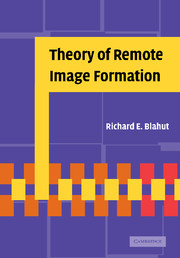Book contents
- Frontmatter
- Contents
- Preface
- Acknowledgements
- 1 Introduction
- 2 Signals in one dimension
- 3 Signals in two dimensions
- 4 Optical imaging systems
- 5 Antenna systems
- 6 The ambiguity function
- 7 Radar imaging systems
- 8 Diffraction imaging systems
- 9 Construction and reconstruction of images
- 10 Tomography
- 11 Likelihood and information methods
- 12 Radar search systems
- 13 Passive and baseband surveillance systems
- 14 Data combination and tracking
- 15 Phase noise and phase distortion
- References
- Index
15 - Phase noise and phase distortion
Published online by Cambridge University Press: 19 August 2009
- Frontmatter
- Contents
- Preface
- Acknowledgements
- 1 Introduction
- 2 Signals in one dimension
- 3 Signals in two dimensions
- 4 Optical imaging systems
- 5 Antenna systems
- 6 The ambiguity function
- 7 Radar imaging systems
- 8 Diffraction imaging systems
- 9 Construction and reconstruction of images
- 10 Tomography
- 11 Likelihood and information methods
- 12 Radar search systems
- 13 Passive and baseband surveillance systems
- 14 Data combination and tracking
- 15 Phase noise and phase distortion
- References
- Index
Summary
A coherent image-formation system is degraded if the coherence of the received waveform is imperfect. This reduction in coherence is due to an anomalous phase angle in the received signal, which is referred to as phase error. Phase errors can be in either the time domain or the frequency domain, and they may be described by either a deterministic model or a random model. Random phase errors in the time domain arise because the phase varies randomly with time. Random phase errors in the frequency domain arise because the phase of the Fourier transform varies randomly with frequency. We will consider both unknown deterministic phase errors and random phase errors in both the time domain and the frequency domain.
Random phase errors in the time domain appear as complex time-varying exponentials multiplying the received complex baseband signal and are called phase noise. Phase noise may set a limit on the maximum waveform duration that can be processed coherently. Random phase errors in the frequency domain appear as complex exponentials multiplying the Fourier transform of the received complex baseband signal and are called phase distortion. Phase distortion may set a limit on the maximum bandwidth that a single signal can occupy. We shall primarily study phase noise in this chapter. Some of the lessons learned from studying phase noise can be used to understand phase distortion.
- Type
- Chapter
- Information
- Theory of Remote Image Formation , pp. 499 - 512Publisher: Cambridge University PressPrint publication year: 2004



